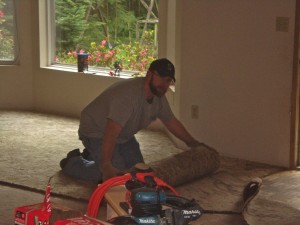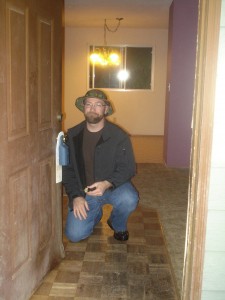(Josh is our newest regular Guest Contributor and will be posting, Rural Relations with Josh, the first Wednesday of every month.)
Three years ago, this December, I stumbled across a real estate listing on Craigslist; it described a heavily treed 5-acre lot with a distressed rambler, built in ’88, in need of a new owner at a fantastic price. The current family had taken out a second mortgage and was in the foreclosure process with a trustee sale a mere three days away. A quick call to the listing agent and we had an appointment the following day to view the house.
 Our first impression of the property was of a cosmetic fixer, on a dead-end road, two foot tall field grass in the yard, various junk strewn in and around the house, and tree branches behind the house attempting to reach inside as nature made a valiant attempt to overtake this small piece of civilization before humans could reign it in. Trees had fallen all over the property during snow and wind storms, blocking all trails and access except by foot beyond the driveway. The list of tasks to make it livable was relatively short as the structure and foundation were solid: remove and replace all flooring and trim, repaint floors, ceilings, and walls, and replace a few doors. Except for those projects, this place had some serious potential and was perfect for a young family with three kids and a dog.
Our first impression of the property was of a cosmetic fixer, on a dead-end road, two foot tall field grass in the yard, various junk strewn in and around the house, and tree branches behind the house attempting to reach inside as nature made a valiant attempt to overtake this small piece of civilization before humans could reign it in. Trees had fallen all over the property during snow and wind storms, blocking all trails and access except by foot beyond the driveway. The list of tasks to make it livable was relatively short as the structure and foundation were solid: remove and replace all flooring and trim, repaint floors, ceilings, and walls, and replace a few doors. Except for those projects, this place had some serious potential and was perfect for a young family with three kids and a dog.
 Beyond the first impression there were two issues to consider, 1) the neighborhood is controlled by an HOA (home owners association), and 2) there is an easement through the south end of the property to a single home at the end of the road. After careful review and talking with the HOA president and a few neighbors, it was determined (and repeatedly stated) that the only reason for the HOA was to maintain the two miles of asphalt road that wound through the development. (The fee for this maintenance was $45 a month, for each property.) Review of the HOA documents revealed that excessive control was possible, although nothing else appeared to be enforced or in place. The easement, we decided, was something we could work with and would not be an issue.
Beyond the first impression there were two issues to consider, 1) the neighborhood is controlled by an HOA (home owners association), and 2) there is an easement through the south end of the property to a single home at the end of the road. After careful review and talking with the HOA president and a few neighbors, it was determined (and repeatedly stated) that the only reason for the HOA was to maintain the two miles of asphalt road that wound through the development. (The fee for this maintenance was $45 a month, for each property.) Review of the HOA documents revealed that excessive control was possible, although nothing else appeared to be enforced or in place. The easement, we decided, was something we could work with and would not be an issue.
Outside those two issues the home and property were great for a prepper! It is one mile from the nearest county road, six miles from the nearest small town, and 20 miles from the nearest mid-size city. It is heavily treed with wood heat; and there is a 160 acre wood lot to the north and a few acres of nature preserve on the east boundary. The only downside is there is no pasture or cleared land other than the yard and house area.
Six months later, through the trustee sale deferral and short sale process, we were first time home and property owners on an adventure with no idea how much we were going to learn.
Please join me in this multi-part series as I write about lessons we’ve learned from our first “homestead” property purchase; lessons that we will apply when we buy our next one.
Josh’s Bio:
Josh is a small business owner, in the greater Seattle area, focused on implementing open source software solutions (think Linux). He grew up in Eastern Washington living several different places with a mother who moved around quite a bit. At 19 years old, Josh joined the Navy; he spent four years on a fast attack submarine stationed at Pearl Harbor, with visits across the Pacific Ocean. He now lives with his wife and three young kids in a rural development, where they have a garden, two dogs and 12 chickens.
(Friday: What We Did This Week To Prep)
